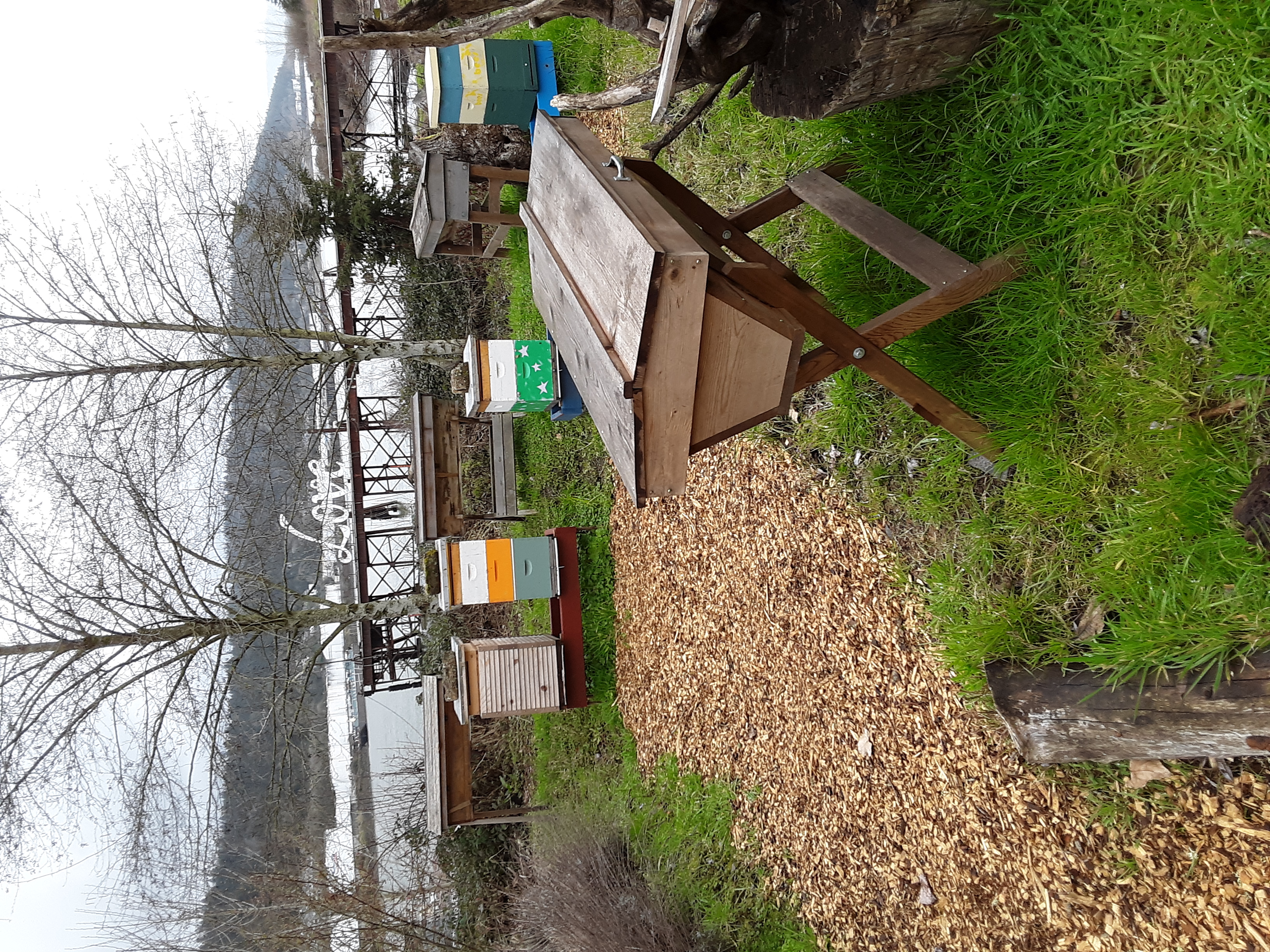An empty beehive, which can be a nucnucleus:
also called a "nuc;" a smaller colony of bees usually with three to five frames. Nucs are splits (divides) made from larger colonies. Nucs are purchased as a method of starting a new colony or as a resource to use to bolster weaker colonies. See more information about nucs <a href="index.cfm?pageID=3093#standard">here</a> and <a href="index.cfm?pageID=3417#nuc">here</a>.
or a standard beehive, or a wood, plastic, or cardboard container that is the approximate size of a standard hive box, elevated on a tree or other structure for the purpose of attracting swarming bees.
A bait hive is an empty structure designed to be attractive to scout beesscout bees:
worker bees that search for pollen, nectar, water, propolis and, during swarming, suitable nesting sites
leaving a hive and preparing to swarm or leaving the swarm bivouacbivouac:
a temporary cluster of swarming honey bees intermediate between leaving home and finding a new nest cavity
searching for a new homesite. Beekeepers usually entice bees to bait hives with old beeswax comb, flower odor (such as lemongrass extract), or with the scent gland extract released by scenting bees (as contained in a swarm lure).
Bait hives may be beehives (nucnucleus:
also called a "nuc;" a smaller colony of bees usually with three to five frames. Nucs are splits (divides) made from larger colonies. Nucs are purchased as a method of starting a new colony or as a resource to use to bolster weaker colonies. See more information about nucs <a href="index.cfm?pageID=3093#standard">here</a> and <a href="index.cfm?pageID=3417#nuc">here</a>.
boxes or standard 8- or 10-frame boxes), or paper, wood, or plastic boxes of various designs. An advantage of using a standard box or a nucnucleus:
also called a "nuc;" a smaller colony of bees usually with three to five frames. Nucs are splits (divides) made from larger colonies. Nucs are purchased as a method of starting a new colony or as a resource to use to bolster weaker colonies. See more information about nucs <a href="index.cfm?pageID=3093#standard">here</a> and <a href="index.cfm?pageID=3417#nuc">here</a>.
for a bait hive is the ease of transfer of a captured swarm to a standard hive. When using non-standard capture boxes, such as the flower pot shown at right, the bees need be transferred as soon as possible to standard bee equipment before they build parallel combs.
Bait hives should be hung in elevated areas 10 feet or more high and visible to the bees. Note that some are not hung but are simply a baited hive placed within the apiary--swarms are known to enter empty stored hive equipment.
Check bait hives every few days during swarm season (a roughly six-week window near the end of spring buildup, during which swarm emergence is most common) and remove any captures to a more convenient location or transfer to standard hive equipment. It is good practice to put any new hive in an area isolated from the rest of your bee hives to be able to check for disease, temperament, and productivity of the new hive before adding it to the established apiaryapiary:
a place where beehives and beekeeping equipment are located; also called a bee yard. An out-apiary is a site away from the owner’s residence. . Swarm captures are excellent comb builders but will likely replace their queen within the first few weeks.
. Swarm captures are excellent comb builders but will likely replace their queen within the first few weeks.
nucleusnucleus:
also called a "nuc;" a smaller colony of bees usually with three to five frames. Nucs are splits (divides) made from larger colonies. Nucs are purchased as a method of starting a new colony or as a resource to use to bolster weaker colonies. See more information about nucs <a href="index.cfm?pageID=3093#standard">here</a> and <a href="index.cfm?pageID=3417#nuc">here</a>.
hive, swarming
Seeley TD, Morse RA and Nowogrodzki R. 1989. Bait Hives for Honey Bees. Cornell Cooperative Extension Information Bulletin No. 187. https://ecommons.cornell.edu/server/api/core/bitstreams/6a183063-f398-4552-b4dd-f14a9488faed/content
Caron D. 2006. Bait hives. Mid-Atlantic Apicultural Research & Extension Consortium Publication 3.7. https://canr.udel.edu/maarec/wp-content/uploads/sites/18/2010/03/BAIT_HIV.pdf
Ostrofsky M. 2017. Get your bait hives ready. Bee Culture. Accessed 2023. https://www.beeculture.com/get-bait-hives-ready/